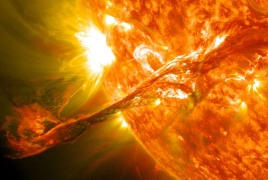NASA scientists want to use the Sun as a massive telescope March 16, 2017 - 12:48 AMT PanARMENIAN.Net - It's a constant struggle to build a better telescope, and one group of scientists from NASA's Jet Propulsion Laboratory want to use the sun to help. Specifically, they want to use the sun's gravity as a giant magnifying glass to search for exoplanets, an idea they outlined at the Planetary Science Vision 2050 Workshop, Popular Mechanics reports. Over a century ago, Einstein's Theory of Relativity told us that gravity massive objects can bend and curve space. This means that very large objects like stars bend the path of anything traveling near them, including light. In fact, this bending of light, called "gravitational lensing," can act much like a regular lens or magnifying glass in the right conditions. It is this property that the scientists wish to exploit by building a telescope that uses this effect to image exoplanets, or planets around other stars. This idea was presented by the JPL scientists at a NASA workshop in late February. Such a telescope could image exoplanets at extremely high resolution, turning a single pixel into an image 1000 pixels across. This is enough to directly observe any continents on exoplanets a hundred light-years away. Such a telescope could provide the clearest pictures of exoplanets by several orders of magnitude and could help scientists search for life or signs of habitability on planets. A gravitational lens telescope could reveal, for the first time ever, what exoplanets truly look like. So why haven't we built one yet? Well, there's a catch. A gravitational lens telescope only works at the solar system's focal point, which happens to lie in interstellar space almost 14 times more distant than the orbit of Pluto. The Voyager 1 spacecraft, which holds the current spacecraft distance record, has only traveled a little over a fifth of the required distance in the past half-century. An aggressive launch with a speedy spacecraft using modern propulsion technology could—in theory—catch up to Voyager in a little over a decade, but it would still be more than 50 years before such a spacecraft is anywhere near the focal point. A gravitational lens telescope would end up being the most future-looking experiment NASA has ever conducted. The JPL scientists suggest that a telescope could also be outfitted to make other observations while on the way to the focal point. For instance, it could make another flyby of Pluto or other nearby objects, study the sun and other planets, and perform more valuable science in addition to exoplanet imaging. This could help incentivize a telescope that otherwise wouldn't get results until the 2060s. Ultimately, such a proposal would have to gain the support of NASA administrators, politicians, and the public, many of whom would need to be convinced to fund a mission so lengthy they wouldn't live to see the results. But the potential is enormous, and we may owe it to future generations to give them the best possible look at worlds around other stars. Yerevan will host the 2024 edition of the World Congress On Information Technology (WCIT). Rustam Badasyan said due to the lack of such regulation, the state budget is deprived of VAT revenues. Krisp’s smart noise suppression tech silences ambient sounds and isolates your voice for calls. Gurgen Khachatryan claimed that the "illegalities have been taking place in 2020." Partner news |